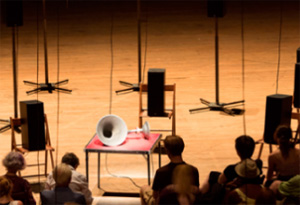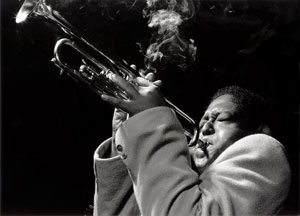Pandering and Performance
John Haberin New York City
Leonard Cohen and Jason Moran
When a star performer enters a museum, it may not be for a performance. In the case of Leonard Cohen, he is already dead.
He comes alive all the same at the Jewish Museum—on video, in covers by other musicians, and in one fan tribute after another. Is that enough? Is it a celebration or pandering to a hunger for celebrity? And what does it have to do with a museum's mission or with art? As a jazz pianist, Jason Moran has been asking about music, memory, art, and performance all along. He comes to the Whitney as a fan, a collaborator, and an artist himself. 
Irony and sobriety
Count on Jews like us to bring a touch of irony, anxiety, and sobriety even to a celebration. Believe me, it is about time. The Brooklyn Museum has descended to a show of David Bowie, the god of glam, as art. MoMA, too, has pandered repeatedly, with icons of popular culture, and the Met with fashion. Now the Jewish Museum devotes more than two floors to a musician as far from glam, glamour, or fashion as one can get. With Leonard Cohen, it sees "A Crack in Everything."
Cohen's image lurks outside in the lobby, as the man in black. Otherwise, there is no clothing or collectible to be had. The curators, John Zeppetelli and Victor Shiffman of the Musée d'Art Contemporain in Montreal, instead ask eleven artists, five of them Canadian like him, to riff on his life and work. The man himself appears in a digital slide show of rudimentary self-portraits and suitably weighty quips. ("I devoted much of my life to not being," but here he is again, even after his death in 2016 at age eighty-two.) Upstairs amid the permanent collection, eighteen musicians cycle through his catalog, including Moby on "Suzanne."
Anything more than covers would be superfluous, from a musician with a near cult following. If you recognize the songs, you probably own every one. If most installations dwell on a single song, that makes sense, too. For the rest of us, they settle into one long drone with little in the way of nuance or music. In the hands of Janet Cardiff and George Bures Miller, an old Wurlitzer issues his reading of a poem as many times, simultaneously, as you press a key. As Cohen liked to say, he had "to be deadly serious about our lives."
Count on a Jew, too, to have mixed feelings about reverence—especially one born to Montreal's "Anglo elite." Yet he was still the cause of reverence in others. Taryn Simon, who has appeared at the museum before in a tribute to Walter Benjamin and in a show on the Lower East Side demanding due process, displays only his obituary in The New York Times—on a front page devoted otherwise to the shock of Donald J. Trump's election in 2016. Kara Blake calls her video archives The Offerings, and I could not help picturing the offering as burnt. Ari Folman has one lie on one's back while a song plays and an animation unfolds, as if in state. It takes timed tickets and a hefty wait at that, like the Sistine Chapel.
On the couch, one might think instead of therapy, which a smart Jew invented, too. Mostly, though, this is fan music, with little space to call one's own. Daily Tous les Jours, a design collective, invites one to hum along (again lying down) while voices sing "Hallelujah." Their number, matching the number of online listeners, reached three hundred even before the public opening. Eighteen more fans (one in a trademark dark tie and fedora) get to sing "I'm Your Man" for Candice Breitz, along with the choir from the Montreal congregation that Cohen called his own even while hanging out at the Chelsea Hotel in New York. Still others cheer to Cohen in performance—in clips from George Fok and Christophe Chassol, in anime from Kota Ezawa, and in a video game from Jon Rafman.
Tacita Dean, whose portraits of the art world have inspired reverence before, films literally a bird on a wire (yes, a song title), but humor and detachment do not often disturb the reverence—not even with a Jew who also practiced Zen. Folman's animation includes a crown of thorns and a cross. One can make a case for a show about art and music, from a writer who took both seriously. Cohen may not have won a Nobel Prize in literature like Bob Dylan, but he did study fiction at McGill, write two novels before his first record contract, and return to poetry. Still, I dread the next museum round of pop tributes. When they get to another native of Canada, Joni Mitchell, will "Both Sides Now" mean the back of the canvas or twice as many collectibles?
Jazz standards
As a jazz musician, Jason Moran has a long memory, even of things that he could never have experienced. He runs to big block chords, with big spaces between them, up and down the piano and in time. At a given moment, he can recall stride piano, Thelonius Monk, or free jazz—but with a patient, airy sound of his own. Even apart from his normal trio, the Bandwagon, he is first and foremost a collaborator and a listener, and so he is at the Whitney. It shows him working with visual and performance artists—as an accompanist and, at times, an artist himself. It shows him in search of sonic equivalents for their art and material equivalents for sound, while attentive to the differences. He could be defining jazz standards for today.
 Moran is not asking to wallow in nostalgia or to hit you over the head with atonal music, although he can be almost too gracious or too all over the joint. Rather, he invites you to find your own direction through jazz. Its history unfolds at the heart of his retrospective with three installations in a single room. They mark stages in time, but also sound stages, and he calls them STAGED. Others throughout the run, mostly musicians, will use them for performance as "Jazz on a High Floor in the Afternoon." (The show fills the top floor of the Whitney, the smallest of three for full-scale exhibitions, adding to the feel of collaboration and intimacy.) They serve, too, as setting for video by a dozen more, with his jazz interludes in between.
Moran is not asking to wallow in nostalgia or to hit you over the head with atonal music, although he can be almost too gracious or too all over the joint. Rather, he invites you to find your own direction through jazz. Its history unfolds at the heart of his retrospective with three installations in a single room. They mark stages in time, but also sound stages, and he calls them STAGED. Others throughout the run, mostly musicians, will use them for performance as "Jazz on a High Floor in the Afternoon." (The show fills the top floor of the Whitney, the smallest of three for full-scale exhibitions, adding to the feel of collaboration and intimacy.) They serve, too, as setting for video by a dozen more, with his jazz interludes in between.
Depending on when you turn up, you might catch such edgy musicians as Oliver Lake, Joanne Brackeen, and Archie Shepp in person. Or you might see black silhouettes of African American oppression by Kara Walker, a closed circle of five pianists from Lorna Simpson, or the ghosts of performers breaking through a thick stage curtain by Carrie Mae Weems. Walker also takes to the sidewalk in front of the museum just one day, for a parade wagon holding a steam calliope. Most often, though, Moran has collaborated with Joan Jonas, who works between video and performance—and between discomfort and dance. In an additional video by the elevators, Glenn Ligon speaks once again for the unspoken, with an attempted remake of a scene from a 1905 silent film based on Uncle Tom's Cabin. In an alcove theater, Stan Douglas pictures the Miles Davis group in 1971, on the cusp between free electric jazz and funk, but with a cast of young musicians today and a woman on drums.
They all play out beside the stages of STAGED. One of the three riffs on the curved backdrop at the Savoy Ballroom in Harlem and the floor lighting in front, in the days of Duke Ellington and Ella Fitzgerald. Another recreates Slugs' Saloon in Alphabet City, when avant-garde jazz and the East Village were just coming to be. "More dive bar than jazz club," says the Whitney, it has sawdust on the floor and cheap art on the wall behind a mere upright piano. Moran could very well have hung out there in the 1960s, except that he was born in 1975. Memory is a funny thing, like art.
One could easily imagine his trio at the Three Deuces on West 52nd Street around World War II, where W. H. Auden sat "uncertain and afraid" and be-bop was in the air. This last stage set barely has room for an upright bass, a tiny drum kit, and a Steinway piano. Gray padding on the walls looks tawdry and dated—but Moran himself erupts on piano, really a player piano, during musical interludes. Things may seem cluttered, but competing sounds and videos never get in each other's way. The curators, Adrienne Edwards with Danielle A. Jackson of the Walker Art Center and the Whitney's Adrienne Edwards, make the performance tracks easy to navigate with a digital wall list, as "Now Playing."
Out front, the pianist makes a case for himself as visual artist even without collaborators. For Run, he applies charcoal and blue pigment to his fingers and his fingers to a keyboard covered with paper. At times he also punches holes in the paper, but elsewhere he lets a simple music box create the score. He is hardly the first since John Cage to treat musical notation as art—or mechanical smudges as expressive abstraction. The smears also look rather like Ligon's video, since Ligon failed to load the camera properly. He must have forgotten to check until it was too late, but Moran, while more open to chance, forgets nothing.

Leonard Cohen ran at the Jewish Museum through September 8, 2019, Jason Moran at The Whitney Museum of American Art through January 5, 2020.




